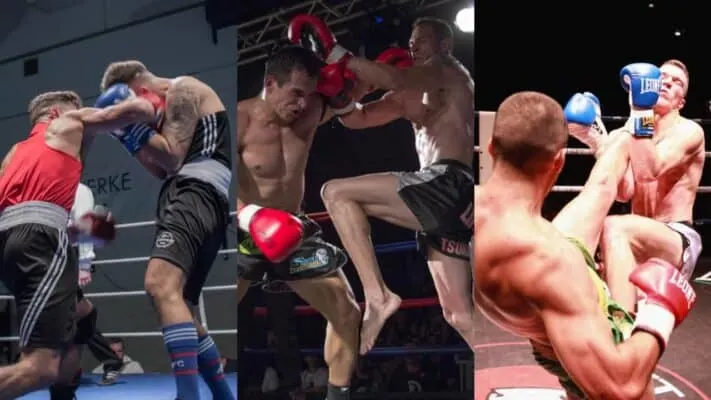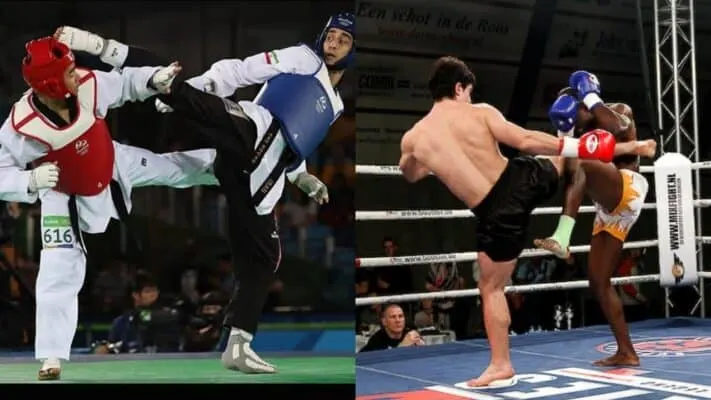
When we say “kickboxing”, most people think of one of the best combat sports. But kickboxing is a broad term, even confusing to some extent as it stands for both a group of specific martial arts and a fighting system on its own.
In the wider sense, kickboxing is a group of arts that mix punches and kicks like Muay Thai, Savate, Karate, or Sanda. But at the same time, kickboxing is a fighting system on its own, created in the 1950s in Japan. This is the main reason why people are often confused by the term kickboxing.
There are five major kickboxing styles: Muay Thai, Dutch kickboxing, Full Contact Karate, Savate, and Sanda. What distinguishes each kickboxing style from the other kickboxing styles is the rules, which explain how you can strike and where you are allowed to strike.
As you will see below, kickboxing has many styles and forms and to average people, they all might look the same. But when you look into it, you can see that these forms differ a lot from one another. In this article, we will explain to you different rules and styles of kickboxing, and answer all the major questions about this striking style.
Different Rules of kickboxing
Kickboxing is a fighting system and combat sport that emerged in the 1950s in Japan. Like any other combat sport, there are different styles of kickboxing that are defined by different rule sets.
K-1 (Asian/Unified rules)
This is one of the most popular forms created by the famous promotion called “K-1” from Japan. The letter “K” stands for karate, kickboxing, and Kung Fu. Back in 1993, K-1 wasn’t created as a style of kickboxing. It was just the name of the promotion that used to promote kickboxing matches and it had its own rules. But K-1 became very popular over the years, so much that we saw the birth of K-1 as a new style of kickboxing.
K-1 kickboxing is very popular mainly because fighters compete at a high pace. Each fight includes 3–3 minute rounds, which means that fighters can fight at a high pace the entire fight. Fighters can use kicks, punches, as well as knee strikes to hurt the opponent and finish the fight.
2. American Kickboxing (Full Contact)
This form emerged in the 1970s in the US. Back in those days, karate and western boxing were the most popular combat sports in the country, and the mix of techniques from both of these combat sports is how American Kickboxing got created.
Fighters wear trousers, and matches last from 3 to 10 rounds, with each round being 3 minutes. They can strike only above the waist using kicks and punches. Elbows, knees, striking below the waist and fighting in the clinch is not allowed.
3. Semi-Contact
The Semi-Contact rule is a variation of American Kickboxing. It is also known as point fighting and it looks very much like karate competition. The emphasis is on light contact and scoring points with fast and precise strikes, instead of chasing a knockout with powerful strikes. All male fighters must wear a shirt, trousers as well as shin guards, boots, and headgear.
4. International Rules
This form is also known as “freestyle”, or “Low Kick” in the US. The rules are the same as in full contact except that it also allows low kicks. Fighters can throw kicks, punches, both above and below the waist. Strikes like elbows and knees are not allowed as well as fighting in the clinch. The length of the matches is the same as in full contact, 3–10 rounds with each round being 3 minutes long.
3. Dutch Style Rules
This is, perhaps, the most famous style that emerged in the 1970s when martial artist Jan Plas brought kickboxing from Japan to the Netherlands. Unlike other styles, it is a mix of techniques from Muay Thai, Kyokushin karate, and western boxing. What makes this style unique is the heavy emphasis on hand strikes and boxing techniques.
The rules of Dutch-style are very much the same as the ones in K-1 and Muay Thai with few exceptions. For instance, fighters can land kicks, punches, and knees. As for the elbow strikes, they are allowed only if both parties agree to it.
Kickboxing Rules
| Rules | Emphasis and Techniques |
| K-1 Rules (Asian or unified Rules) | Striking both above and below the waist and fighting in the clinch is allowed. Kicks, punches, and knees |
| American kickboxing Rules (Full Contact) | Striking below the waist is forbidden so there are no leg kicks. Fighters can use only kicks and punches. |
| Semi-Contact Rules | Emphasis is on light contact and scoring points with fast and precise strikes. Fighters can utilize kicks and punches and must wear a shirt, trousers, boots, shin guards and headgear. |
| International Rules | Fighters can strike both the area above and below the waist utilizing kicks and punches. Fighting in the clinch, elbow and knee strikes are forbidden. |
| Dutch Style Rules | The emphasis is on western boxing techniques, and mixing them with the kicks. Fighters can strike both above and below the waist using punches, kicks and knees. |
What are Different Styles(types) of kickboxing?
Here are most popular types of kickboxing, and we have also created a table of all types which you can find below.
- Muay Thai – is one of the best striking arts and a national sport in Thailand. The focus of the art is on using all limbs as weapons to strike with kicks, punches, knees, and elbows. The emphasis is on hard kicks and fighting at close range and in the clinch.
- Savate – is a French form of kickboxing that is a mix of English boxing techniques and foot kicks. It differs a lot from other styles because its fighters wear unique designed boots, trousers, and a vest. The main difference is that savate fighters can land kicks only with their foot, not with the shin or knee as in other forms of kickboxing.
- Lethwei – is the most brutal form of kickboxing as it is bare-knuckle and fighters can utilize headbutts. The rules and the techniques they use are very much the same as the ones in Muay Thai. They can use all limbs to fight using kicks, punches, knees, elbows, and notorious headbutts.
Different Styles(types) of Kickboxing
| Muay Thai | Is a hard kickboxing style that allows strikes above and below the waist, and clinch fighting. The emphasis is on hard kicks, fighting in the clinch with elbows and knees, and punches. |
| Lethwei | Lethwei is a brutal kickboxing style that is very similar to Muay Thai. But on top of kicks, punches, knees and elbows, Lethwei adds notorious headbutts, and fighters compete bare knuckle. |
| Japanese Kickboxing | Japanese kickboxing is a mix of Muay Thai techniques and rules, and techniques from Kyokushin karate. It emerged in the 1960s in Osaka, Japan. |
| Shoot Boxing | In addition to kicks, punches, knees and throws, Shootboxing utilizes standing submissions like chokes and joint locks. |
| Kun Gek Do | This is a Korean form of kickboxing that is a mix of Taekwondo and Muay Thai techniques. |
| Sanda (Sanshou) | This is a Chinese version of kickboxing where fighters can strike using kicks, punches, fight in the clinch and execute throws and sweeps. Elbow and knee strikes are not allowed, with the exception of some competitions. |
| Yaw-Yan | Yaw-Yan is a Filipino version of Kickboxing that is very similar to Muay Thai when it comes to rules and techniques. |
| Karate (Full Contact) | Karate has many styles and forms out which most focus on mixing kicks and punches. Some styles allow elbow and knee strikes as well as throws and fighting in the clinch. |
| Savate | Savate is a French martial art that represents a mix of English boxing techniques and foot strikes. |
Which Style(Type) of Kickboxing is the best?
Muay Thai is the best and most popular type of kickboxing. It is much better and more effective than other types like French Savate or Sanda. The others might think that Lethwei is better, and there is a strong argument for that. But Muay Thai teaches you the same skills, and it is much safer overall.
Muay Thai is a complete striking art that will teach you all about real fighting. Students learn how to fight at all ranges using all limbs as weapons and deliver each strike with a lot of power. The emphasis is on hard kicks, clinch fighting using brutal elbows and knees, and boxing. It is very effective for self-defense and it is also a very popular sport as well.
The other good kickboxing style is Lethwei. But this style is too brutal as fighters compete bear knuckle. It teaches the same techniques as Muay Thai, but it adds the infamous headbutts. It is a very dangerous style, and not everyone’s cup of tea, that’s for sure. On top of that, it is not as accepted across the world or as popular as Muay Thai, which is one of the reasons why Muay Thai is better.
What is the Difference between K-1 and Dutch Style of Kickboxing?
K-1 is a set of rules created by the famous Japanese “K-1” promotion that later became a new style of kickboxing. The emphasis of this style is on fighting at a high pace and throwing each strike with a lot of power. The matches have 3 rounds, with each round being 3 min long. Or in other words, fighters can push a high pace and don’t worry too much about gassing out. It is, perhaps, the most intense style of kickboxing that is very popular in all parts of the world.
Dutch style, on the other side, is not any less effective. The rules are very much the same as in K-1 but the main difference is the emphasis. The emphasis of the Dutch style is on western boxing and mixing them together with the kicks. Instead of throwing each strike with a lot of power, the focus is on technique, accuracy, and high output. Dutch style fighters would often throw five punch combo before finishing it with a leg kick, which is a style that differs a lot from K-1.
Overall, K-1 and Dutch styles are very similar with each one having pros and cons.
How is Muay Thai Different from Dutch Style Kickboxing?
At first sight, Muay Thai and Dutch-style kickboxing might look the same as these two styles share a lot in common. But when you look deep into it, these two differ a lot when it comes to rules, techniques, and emphasis. Here is all you need to know.
Emphasis
The emphasis in Muay Thai is on kicks and throwing each strike with a lot of power. Instead of having a high output, fighters focus on doing big damage with a single strike and they always push for a knockout. Although fights can end in a decision, the main goal of Muay Thai is to finish the opponent.
In Dutch style, on the other side, the emphasis is on the high output of strikes, and western boxing techniques. Most fighters tend to have very technical striking, and they focus on picking the opponent apart with high volume, accuracy, and relentless pace. While Thai boxers focus on a single power strike at the time, kickboxers rarely do such a thing. They would explode with five punch combo and finish the attack with a kick or a knee.
Kicking Techniques
Muay Thai is also known as the art of eight limbs as fighters can strike using kicks, punches, knees, and elbows. However, boxing is not that important in Muay Thai as the emphasis is on advanced kicking techniques. Fighters use punches just to set up the kicks or close the distance to pull the famous Thai clinch from which they can land knee and elbow strikes. Muay Thai fighters tend to fully extend their leg when throwing a kick, and they land with their lower part of the shin (tibia).
There are many variations of how you throw a kick in kickboxing. In Dutch Style, fighters would lift their leg up, snap the knee and connect with their foot.
Rules of competition
Muay Thai rules are pretty simple and do not vary too much across different promotions. Here are some general rules of Muay Thai you should be aware of:
- Muay Thai fighters compete in the ring
- Matches have 5 rounds with each round lasting 3 minutes, and there is a 2-minute break between the rounds.
- Fighters can strike using punches, kicks, elbows, knees
- Clinch and throwing the opponent to the ground is allowed
- Promotions use a boxing scoring system to pick a winner if a fight ends in a decision.
Dutch style rules of kickboxing are very similar to the ones in Muay Thai:
- Fighters compete in the square ring
- Matches have 3 rounds with each round being 3 minutes long, and there is a 1-minute break between.
- Fighters can throw kicks, punches, knees, while elbows are forbidden.
What Fighting Style is Used in the Movie “Kickboxer”?
In the movie “Kickboxer”, the main actor and martial artist, Jean Claude Van Damme used techniques from:
- Karate
- Taekwondo
- Muay Thai
Van Damme got into martial arts at a very young age by training in “Shotokan” karate. After earning a black belt in the late 1970s, he would start competing in various karate and kickboxing matches, and become a European karate champ.
Later on, he would move to live in the U.S. where he started training Tae Kwon Do and Muay Thai, two of the most popular arts of that time. This mix of karate, Tae Kwon Do, and Muay Thai skills really made Van Damme’s fighting style unique. In his movies, notably the “Kickboxer”, we could see him throwing various spinning kicks, doing splits, and chopping bamboos with kicks.
Is TKD Better than Kickboxing?
No, Taekwondo(TKD) is not better because kickboxing is a more versatile fighting style. In short, Taekwondo is too one-dimensional as it puts too much emphasis on the kicks. Students rarely learn how to throw punches, even when they do, they can strike the body area below the neck. This is mainly because the Taekwondo rules favor kicks, and forbid punches to the head. Although the initial forms of the art used to teach solid hand strikes, and even the basics of grappling, modern taekwondo is all about the kicks.

Kickboxing also puts a lot of emphasis on sport and competition, but most styles are also very effective for self-defense as well. Kickboxing teaches you advanced kicks, punches, and how to mix them together with knee and elbow strikes. In most styles, the focus is not on scoring points like in Taekwondo, but rather on knocking the opponent out. This on its own makes kickboxing much better for real fighting and self-defense in general.
Taekwondo vs Kickboxing – Key Differences and Comparison – This article delves into the key difference between TKD and Kickboxing. Knowing this key difference will greatly help you decide which striking art is right for you.
